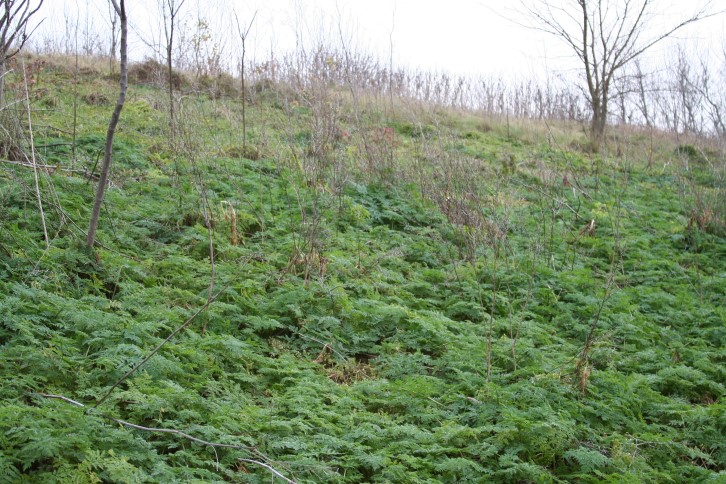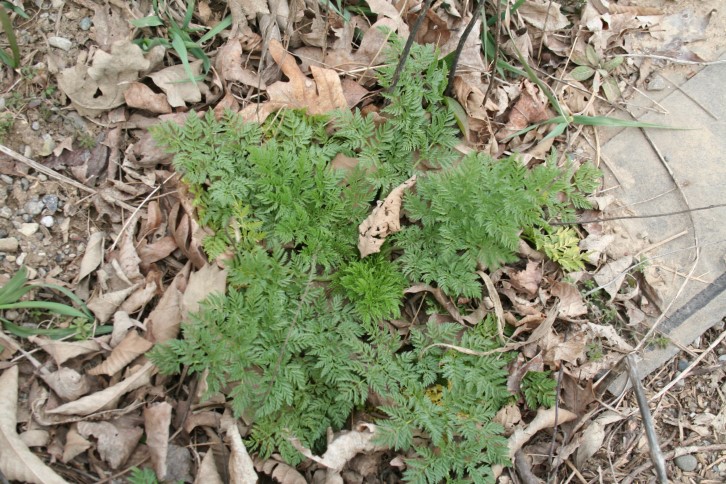Every spring we receive phone calls and emails with concerns of the presence of poison hemlock (Conium maculatum L.) in pastures, fencelines, and field edges (Figure 1). This plant can be noticed very early in the spring every year, as it is typically one of the first weeds to green up, usually in late February to early March if temperatures are favorable. The appearance of poison hemlock on roadsides and fencerows of Indiana is not new as we can find articles in the Purdue Weed Science database dating back to 2003. The largest threat of this weed is the toxicity of it’s alkaloids if ingested by livestock or humans, but it can also reduce aesthetic value of landscapes and has been reported to creep into no-till corn and soybean fields as well.
Biology and Identification
Poison hemlock is a biennial weed that exists as a low growing herb in the first year of growth (Figure 2) and bolts to three to eight feet tall in the second year, when it produces flowers and seed (Figure 3). It is often not noticed or identified as a problem until the bolting and reproductive stages of the second year. The alternate compound leaves are pinnate (finely divided several times) and are usually triangular in outline. Flowers are white and occur in an umbel inflorescence. Poison hemlock is often confused with wild carrot but can be distinguished by its lack of hairs and the presence of purple blotches on the stems.
Toxic Properties
Poison hemlock contains five alkaloids that are toxic to humans and livestock and can be lethal if ingested. The plant’s alkaloids may also be absorbed through the skin, so if you find yourself hand pulling poison hemlock, it would be a good idea to wear gloves. All parts of the plants contain the toxic alkaloids with levels being variable throughout the year. Symptoms of toxicity include nervousness, trembling, and loss of coordination followed by depression, coma, and/or death. Initial symptoms will occur within a few hours of ingestion.
Cases of poisoning due to poison hemlock ingestion are rare as the plants emit a mousy odor that makes it undesirable and unpalatable to livestock and humans. Consumption and toxicity in animals usually occurs in poorly managed or overgrazed pastures where animals are forced to graze poison hemlock because of lack of desirable forage.
Control
Control of poison hemlock with herbicides is most effective when applied to plants in the first year of growth or prior to bolting and flowering in the second year. The closer to reproductive stages, the less effective the herbicide. In roadside ditches, pastures, and waste areas, herbicides containing triclopyr (Remedy Ultra, Garlon, many others) or triclopyr plus 2,4-D (Crossbow, Crossroad) are most effective in controlling poison hemlock. Other herbicides that provide adequate control when applied at the proper timing are dicamba (Clarity, many others), metsulfuron-methyl (Escort XP), metsulfuron-methyl plus dicamba plus 2,4-D (Cimarron Max) and clopyralid plus 2,4-D (Curtail). For no-till fields, mixtures of 2,4-D plus dicamba will be most effective for fields going to soybean. Be sure to pay attention to preplant intervals when these herbicides are used in the spring. Preplant intervals will vary based on the soybean herbicide-resistance trait to be planted and whether or not 2,4-D and dicamba were used together to control the weed. For fields going to corn, mesotrione (CallistoTM and other names) and mesotrione premixes + 2,4-D or dicamba have been effective in reducing infestations along field edges.
For further information on toxic plants in Indiana refer to the Purdue University Weed Science Guide to Toxic Plants in Forages (https://www.extension.purdue.edu/extmedia/WS/WS_37_ToxicPlants08.pdf)





